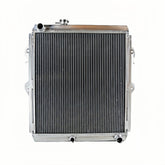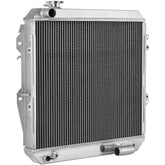Aussie Winter Car Cooling System Maintenance Guide: Key Tips & Expert Advice
Aussie Winter Car Cooling System Maintenance Guide: Key Tips & Expert Advice
Here’s the text we’re diving into: Australia’s winter (June-August) brings chilly temperatures that can put extra strain on your car’s cooling system. When it gets cold, coolant performance can dip, hoses might harden and age, and dirt in the radiator can clump together, making it harder for heat to escape. If you let maintenance slide, you could end up facing problems like engine overheating and cooling system breakdowns. This article pulls together insights from trusted sources like, along with advice from local Aussie mechanics, to share essential winter cooling system maintenance tips that will help keep your car running smoothly all season long.
The Importance of Winter Cooling System Maintenance in Australia
Even though Australia doesn’t see extreme winter chills, the consistent low temperatures from June to August can change how the cooling system works. Coolant might lose its fluidity in the cold, hoses can become less flexible and crack, and dirt in the radiator can thicken, which hampers heat dissipation. According to NRMA’s 2024 Winter Vehicle Health Report, 35% of winter car breakdowns stem from poor cooling system maintenance—most of these problems can be easily avoided with some basic care.
Essential Winter Car Cooling System Maintenance Tips (Supported by Expert Data)
-
Check Your Coolant Level Monthly to Dodge “Low-Level Risks”
How to do it: Pop the hood, find the coolant reservoir, and see if the level sits between the “MIN” (minimum) and “MAX” (maximum) indicators. If it’s below “MIN,” top it off with the same type of coolant (never mix different brands or types).
Expert Tip: NRMA data reveals that 65% of Aussie car owners skip this crucial step, which directly leads to of winter engine overheating problems. Even if the coolant level looks fine, keep an eye out for any unusual drops, as they could signal a small leak.
2. How to do it: Start by gently squeezing the cooling system hoses, but only when the vehicle is cool.
If they feel stiff, lack elasticity when you press them, or show any cracks or bulges, it’s a sign they’re old and need to be replaced right away. Dave, our go-to mobile mechanic in Brisbane, mentions that he sees about 12 to 18 cars each week during winter with cooling system issues due to cracked hoses. These hoses tend to harden in the cold and can break from the vibrations of the engine. While replacing them is relatively inexpensive (around AU$20-$50 per hose), the cost of being stranded or delayed is much higher.
3. Flush the Cooling System Every 2 Years to Remove Dirt Buildup
Why it matters: Over time, dirt and scale can cling to the inside of the radiator, making it harder for heat to transfer. Flushing the system regularly helps clear out this buildup and keeps your cooling system running efficiently.
Authoritative Data: According to research from the Australian Automotive Aftermarket Association , regularly flushing the cooling system every two years can cut failure rates by 50% and prolong the life of both the radiator and water pump. It’s best to have this done at a professional shop to ensure all the dirt is cleared out.
4. Inspect the Radiator Cap for “Low-Cost Protection”
Key Steps: First, make sure the radiator cap is tightened properly—if it’s loose, it can lead to coolant leaks and insufficient pressure. If the cap is older than three years, it’s wise to replace it, even if it looks fine. Old sealing gaskets can lose their grip, causing coolant to evaporate quickly.
Expert Advice: Penrite’s 2024 Coolant Usage Guide highlights that swapping out the radiator cap is a “low-cost solution” to prevent leaks in the cooling system. A new cap only costs about AU$15-$30, but it can save you from costly engine damage due to leaks, which could run into the hundreds of dollars to fix.
Extra Tips for Winter Cooling System Maintenance
Choose the Right Coolant for Australian Winters: Winter temperatures can vary quite a bit across Australia (for instance, Melbourne usually sees a winter low of about 5°C, while Tasmania can dip down to 0°C). It’s a good idea to pick a coolant that has a freezing point 5-10°C lower than the coldest temperature in your area to keep it from freezing up when the weather gets chilly.
Avoid “Using Water as a Coolant Substitute”: Some car owners might be tempted to add water when their coolant levels are low, but water has a higher freezing point and can lead to scale buildup. Using it for too long can speed up corrosion in your cooling system. If you find yourself in a pinch and need to add water, make sure to switch back to regular coolant as soon as you can.
Address Issues Right Away: If you notice things like a “high temperature gauge reading” or a “coolant smell under the hood” while driving in winter, pull over and check it out immediately—don’t keep driving. Cooling system problems can escalate quickly in cold weather, potentially causing serious damage like engine cylinder scoring.
 Taking care of your car’s cooling system in winter is all about “prevention first.” Just four simple steps—checking levels monthly, replacing hoses on time, flushing the system regularly, and inspecting the radiator cap—can help you avoid most issues. If you need coolant, hoses, or other parts that fit your vehicle, or if you have any maintenance questions, check out our website. We offer products that work with all major car models in Australia, and our team is here to provide personalized maintenance advice to help keep your car running smoothly all winter long.
Taking care of your car’s cooling system in winter is all about “prevention first.” Just four simple steps—checking levels monthly, replacing hoses on time, flushing the system regularly, and inspecting the radiator cap—can help you avoid most issues. If you need coolant, hoses, or other parts that fit your vehicle, or if you have any maintenance questions, check out our website. We offer products that work with all major car models in Australia, and our team is here to provide personalized maintenance advice to help keep your car running smoothly all winter long.







Leave a comment
Please note, comments need to be approved before they are published.